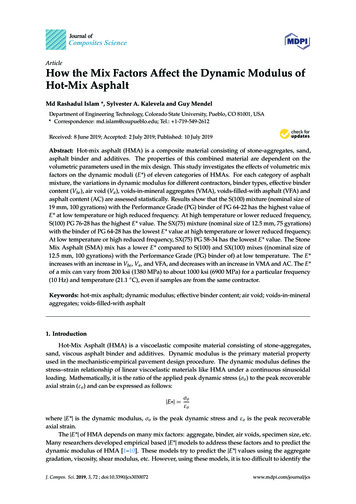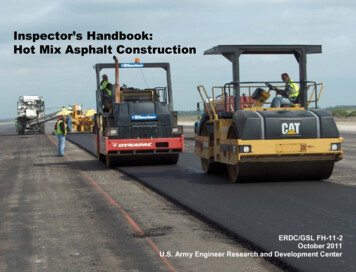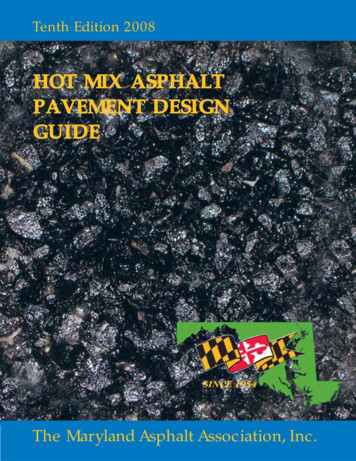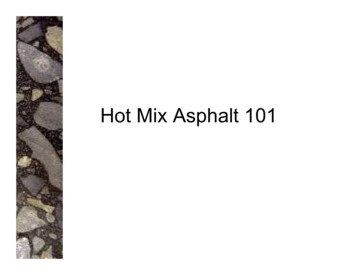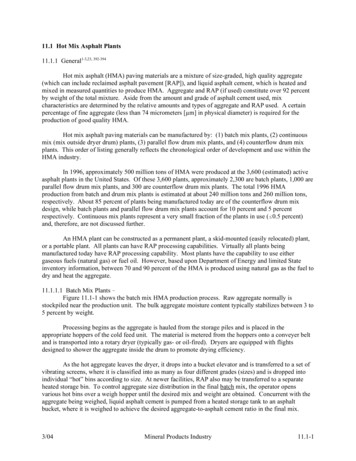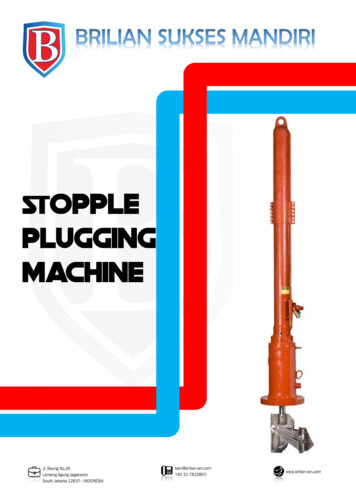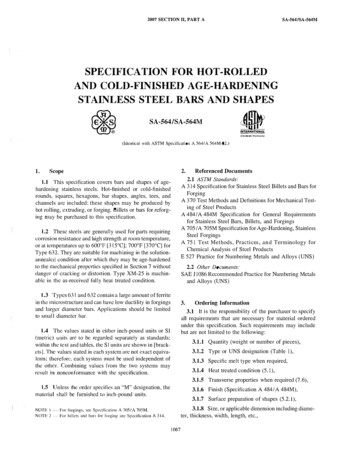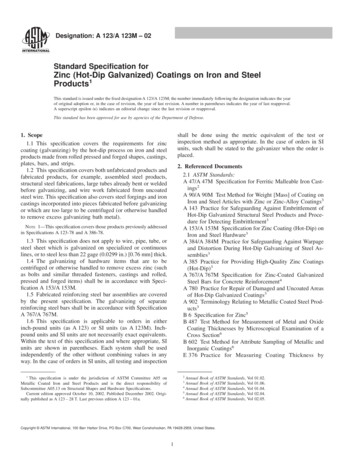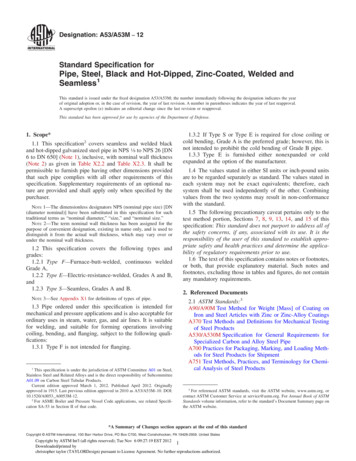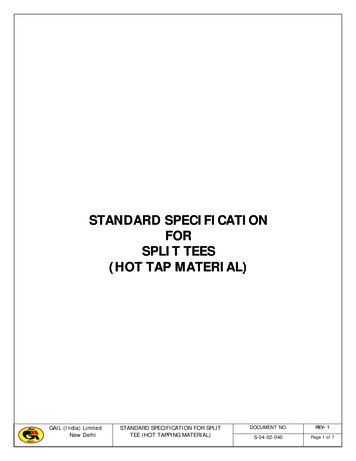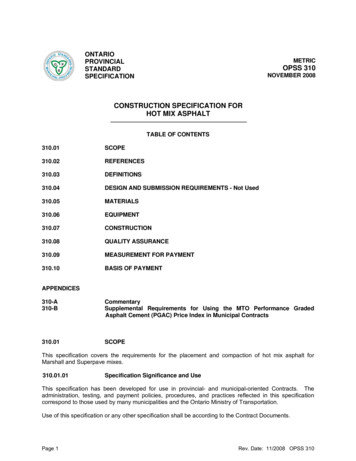
Transcription
ONTARIOPROVINCIALSTANDARDSPECIFICATIONMETRICOPSS 310NOVEMBER 2008CONSTRUCTION SPECIFICATION FORHOT MIX ASPHALTTABLE OF NS310.04DESIGN AND SUBMISSION REQUIREMENTS - Not ON310.08QUALITY ASSURANCE310.09MEASUREMENT FOR PAYMENT310.10BASIS OF PAYMENTAPPENDICES310-A310-BCommentarySupplemental Requirements for Using the MTO Performance GradedAsphalt Cement (PGAC) Price Index in Municipal Contracts310.01SCOPEThis specification covers the requirements for the placement and compaction of hot mix asphalt forMarshall and Superpave mixes.310.01.01Specification Significance and UseThis specification has been developed for use in provincial- and municipal-oriented Contracts. Theadministration, testing, and payment policies, procedures, and practices reflected in this specificationcorrespond to those used by many municipalities and the Ontario Ministry of Transportation.Use of this specification or any other specification shall be according to the Contract Documents.Page 1Rev. Date: 11/2008 OPSS 310
310.01.02Appendices Significance and UseAppendices are not for use in provincial contracts as they are developed for municipal use, and then, onlywhen invoked by the Owner.Appendices are developed for the Owner’s use only.Inclusion of an appendix as part of the Contract Documents is solely at the discretion of the Owner.Appendices are not a mandatory part of this specification and only become part of the ContractDocuments as the Owner invokes them.Invoking a particular appendix does not obligate an Owner to use all available appendices. Only invokedappendices form part of the Contract Documents.The decision to use any appendix is determined by an Owner after considering their contractrequirements and their administrative, payment, and testing procedures, policies, and practices.Depending on these considerations, an Owner may not wish to invoke some or any of the availableappendices.310.02REFERENCESWhen the Contract Documents indicate that provincial-oriented specifications are to be used and there isa provincial-oriented specification of the same number as those listed below, references within thisspecification to an OPSS shall be deemed to mean OPSS.PROV, unless use of a municipal-orientedspecification is specified in the Contract Documents. When there is not a corresponding provincialoriented specification, the references below shall be considered to be to the OPSS listed, unless use of amunicipal-oriented specification is specified in the Contract Documents.When the Contract Documents indicate that municipal-oriented specifications are to be used and there isa municipal-oriented specification of the same number as those listed below, references within thisspecification to an OPSS shall be deemed to mean OPSS.MUNI, unless use of a provincial-orientedspecification is specified in the Contract Documents. When there is not a corresponding municipaloriented specification, the references below shall be considered to be the OPSS listed, unless use of aprovincial-oriented specification is specified in the Contract Documents.This specification refers to the following standards, specifications, or publications:Ontario Provincial Standard Specifications, MaterialOPSS 1003OPSS 1101OPSS 1103OPSS 1150OPSS 1151Aggregates - Hot Mix AsphaltPerformance Graded Asphalt CementEmulsified AsphaltHot Mix AsphaltSuperpave and Stone Mastic Asphalt MixturesOntario Ministry of Transportation PublicationsMTO Laboratory Testing Manual:LS-261Preparation of Marshall SpecimensLS-262Bulk Relative Density of Compacted Bituminous MixturesLS-263Resistance to Plastic Flow of Bituminous Mixtures Using Marshall ApparatusLS-264Theoretical Maximum Relative Density of Bituminous Paving MixturesLS-265Percent Air Voids in Compacted Dense Bituminous Pavement MixturesLS-282Quantitative Extraction of Asphalt Cement and Analysis of Extracted Aggregate fromBituminous Paving MixturesPage 2Rev. Date: 11/2008 OPSS 310
LS-287LS-292LS-306The Determination of Percent Compaction of Compacted Bituminous Paving Mixture(MRD Method)Quantitative Determination of Asphalt Cement Content by Ignition and Analysis ofRemaining Aggregate from Bituminous Paving MixturesBulk Relative Density of Compacted Bituminous Mixtures Using Paraffin-CoatedSpecimensASTM InternationalD 6752-03e1Standard Test Method for Bulk Specific Gravity and Density of Compacted BituminousMixtures Using Automatic Vacuum Sealing MethodAmerican Association of State Highway and Transportation Officials tandard Specification for Performance Graded Asphalt BinderStandard Specification for Superpave Volumetric Mix DesignBulk Specific Gravity of Compacted Bituminous Mixtures Using Saturated Surface-DrySpecimensTheoretical Maximum Specific Gravity and Density of Bituminous Paving MixturesBulk Specific Gravity of Compacted Bituminous Mixtures Using Paraffin-CoatedSpecimensDEFINITIONSFor the purpose of this specification, the following definitions apply:AMRL means the AASHTO Materials Reference Laboratory.Attribute means one of the following: Designated Large Sieve (DLS), 4.75 mm sieve, 600 μm sieve,75 μm sieve, asphalt cement content, air voids, or compaction.Binder Course means a hot mix asphalt (HMA) course between a surface course and either a basecourse or stabilized base course, an existing pavement, or another HMA binder course.CCIL means the Canadian Council of Independent Laboratories.Designated Large Sieve (DLS) means the sieve size specifically designated for each mix type forgradation testing according to Table 1.Fat Spot means an area of pavement substantially blacker than the surrounding pavement.Hot Mix Asphalt (HMA) means hot mixed, hot laid asphaltic concrete, including Marshall, Superpave,and Stone Mastic Asphalt (SMA) mixes. The terms are used interchangeably. HMA may includerecycled or specialty mixes.Hot Mix Asphalt Miscellaneous means HMA that is placed in areas other than the roadway, as specifiedin the Contract Documents.Hot Mix Asphalt Padding means an HMA layer used for correcting crossfall and profile deficiencies inthe existing pavement before placing the levelling, binder, or surface course.Hot Mix Asphalt Patching means an HMA surface course placed over localized areas of distressedpavement, generally for the purpose of improving strength, rideability, or safety.Page 3Rev. Date: 11/2008 OPSS 310
Job-Mix Formula (JMF) means the percentage passing on each designated sieve of the total mass ofaggregate and the amount of asphalt cement as a percentage by mass of the mix that are based onspecified mix design procedures that when mixed result in an HMA that is according to this specification.Joint means a vertical contact between an HMA pavement course and any HMA pavement or any rigidobject that exists at the time the HMA is laid.Levelling Course means an HMA course of variable thickness used to eliminate transverse andlongitudinal irregularities on an existing surface prior to placing an HMA binder or surface course.Lot means a specific quantity of material or a specific amount of construction normally from a singlesource and produced by the same process.Mix Properties means the per cent passing the DLS, 4.75 mm sieve, 600 μm sieve, and 75 μm sieve;the asphalt cement content; and the air voids.Paving in Echelon means two or more pavers are used to pave multiple adjacent lanes simultaneously,within 60 m of each other.Performance Graded Asphalt Cement (PGAC) means an asphalt binder that is an asphalt-basedcement produced from petroleum residue, either with or without the addition of non-particulate modifiers,according to AASHTO M320.Quality Assurance (QA) means a system or series of activities carried out by the Owner to ensure thatmaterials received from the Contractor meet the specified requirements.Quality Control (QC) means a system or series of activities carried out by the Contractor to ensure thatmaterials supplied to the Owner meet the specified requirements.Random Sample means a sample from a location chosen by the Contract Administrator based onrandom numbers such that any portion of a lot or sublot has an equal probability of being selected.Range means the numerical difference between the maximum and minimum test results within a lot.Reclaimed Asphalt Pavement (RAP) means the processed HMA material that is recovered by partial orfull depth removal.Referee Testing means testing by an independent laboratory selected by the Owner and acceptable tothe Contractor, the results of which are used for resolving differences between QC and QA testing.Screed means the unit of the paver that strikes off and imparts initial compaction to the HMA.Segregation means a condition of the pavement characterized by areas with comparatively coarser orfiner texture than that of the surrounding pavement.Southern Ontario means that area of Ontario south of a line joining Waubaushene, Severn Bridge,Bancroft, and Ottawa.Stone Mastic Asphalt or Stone Matrix Asphalt (SMA) means HMA consisting of two parts of a coarseaggregate skeleton and an asphalt binder rich mortar. The mix has a gap graded aggregate skeleton withcoarse aggregate stone-on-stone contact.Sublot means approximately equal divisions or portions of a lot.Page 4Rev. Date: 11/2008 OPSS 310
Superpave means an acronym for Superior Performing Asphalt Pavements. It is an alternative system tothe Marshall method for specifying material components and asphalt mix design using the Superpavegyratory compactor.Surface Course means an HMA wearing course of any flexible or composite pavement.Vertical Surface means all edges of concrete curbs, catch basins and other appurtenances, longitudinaljoints, and transverse joints for application of tack coat.310.05MATERIALS310.05.01Hot Mix AsphaltThe materials used in the production of the HMA shall be according to OPSS 1150 for Marshall mixesand OPSS 1151 for Superpave and SMA mixes.310.05.02Tack Coat MaterialTack coat shall consist of SS-1 emulsified asphalt diluted with an equal volume of water. The undilutedmaterial shall be according to OPSS 1103.The use of an alternate product may be permitted at the Contractor’s request provided that such arequest is submitted in writing to the Contract Administrator a minimum of 14 Days prior to the intendeduse of the alternate product. The Contractor’s proposal shall include, but not be limited to, the following:a) The reasons for the use of the alternate material.b) Material Safety Data Sheets and any other information for the safe handling, transportation, andstorage of the product.c) Testing protocols to be used in confirming the properties of the material.d) Typical test results.e) Required application rates.f)Cost implications for the use of the alternate product.The Contract Administrator shall review this proposal and respond in writing within 7 Days of receiving it,either accepting the use of the alternate product or not accepting its use with reasons. The alternateproduct shall not be used until permission has been granted in writing by the Contract Administrator.310.06EQUIPMENT310.06.01Paving EquipmentAsphalt pavers shall be self-propelled and capable of laying a consistent satisfactory mat that is true tothe crossfall, profile, cross-section, and alignment specified in the Contract Documents. Pavers shall beequipped with hoppers and distributing augers capable of placing the HMA evenly in front of the screeds.Screeds shall be capable of being heated and being adjustable as to level and crown. Pavers shall becapable of simultaneously placing the shoulder pavement and roadway pavement whether the shoulderpavement is at the same or different crossfall from the roadway pavement.Page 5Rev. Date: 11/2008 OPSS 310
In all cases, pavers shall be equipped with automatic longitudinal and transverse grade and slopecontrols capable of being operated from either side of the paver. The longitudinal grade control shall beadjustable for mat thickness in small increments, without the necessity of stopping the paver. The pavershall be equipped to operate from either a 12 m ski or floating beam, a 3 m ski, or a joint matching shoe.Where the ski is a flexible unit, it shall be equipped with a spring-tensioned wire extending betweenbrackets fitted on and slightly above each end of the ski. The sensing grid shall ride on the wire, not onthe ski.Plows or other edge ramping devices that are attached to or towed by the screed portion of the pavershall not be permitted.A 3 m straight edge shall be provided on each paver. This straight edge shall be made of metal with alevel recessed in its upper surface parallel to the lower edge.310.06.02Rollers310.06.02.01Classification of RollersRollers shall be classified into categories as follows:Class SSelf-propelled steel-drum, tandem, or three-wheel rollers according to Table 2.Class RSelf-propelled pneumatic-tired rollers according to Table 3.Class VSelf-propelled vibratory rollers specifically designed for HMA compaction having either dualvibratory rolls or a combination of vibratory roll and pneumatic tires with a contact area equalto or greater than 70% of the roll width according to Table 4.310.06.02.02Requirements for Rollers310.06.02.02.01GeneralAll rollers shall be capable of reversing without backlash.The Contract Administrator shall be provided with the mass of the rollers. The Contract Administratormay require the weighing of the rollers in his presence.The rolls or drums shall be kept moist with water or non-petroleum based release agents to preventadhesion of HMA to them. Excess water or release agents shall not be permitted.310.06.02.02.02Steel-Drum RollersThe drums of tandem steel-drum rollers shall not be less than 1.20 m in width.310.06.02.02.03Pneumatic-Tired RollersPneumatic-tired rollers shall be constructed such that the wheels on either the front or back oscillateeither independently or in pairs.
Hot Mix Asphalt Padding means an HMA layer used for correcting crossfall and profile deficiencies in the existing pavement before placing the levelling, binder, or surface course. Hot Mix Asphalt Patching means an HMA surface course placed over localized areas of distressed pavement, generally for the purpose of improving strength, rideability, or safety. Page 3 Rev. Date: 11/2008 OPSS 310 .
